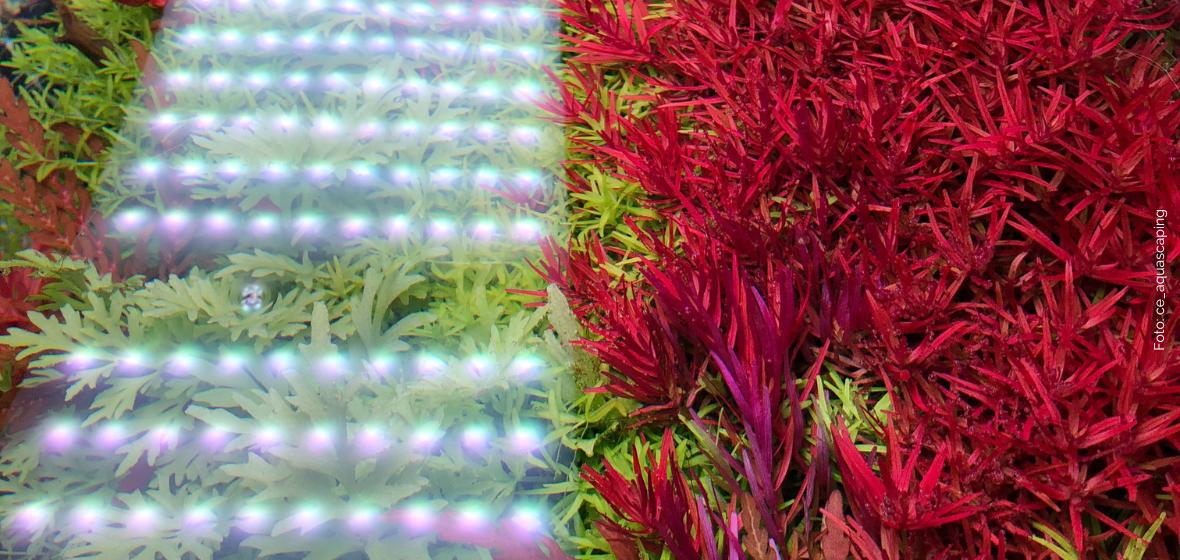So you’ve already set up the plants in your aquarium with all the bells and whistles and everything looks like it’s in order. There’s just one final thing that you need to take care of before you step back and enjoy your aquascape — lighting! You’ll need to know how to light your tank for optimal plant growth. Traditional lighting options such as fluorescent bulbs worked well in the past but because LED technology has come a long way, most aquarists tend to favour LED lights when it comes to planted aquariums.
This guide will explore the different factors to consider when selecting your aquarium lights for your underwater oasis. While cheaper alternatives such as LED floodlights or desk lamps can encourage some level of plant growth, they simply do not offer the specialised features needed for a thriving tank.
Table of contents:
- What is the light spectrum? And why does it matter for your aquarium?
- Kelvin vs spectrum
- Blue, red and green spectrum: what is their function?
- How to read a light spectrum chart
- Choosing the best spectrum for your aquarium
- Green spectrum: the myth of algae and usage
- Conclusion
What is the light spectrum? And why does it matter for your aquarium?
The light spectrum is a range of electromagnetic radiation that is visible to the human eye, measured in nanometers (nm). In an aquarium setting, optimal lighting for plant photosynthesis also affects the visual perception of colors. The spectrum includes colors from violet (400 nm) to red (700 nm), each influencing the biological processes in different ways.
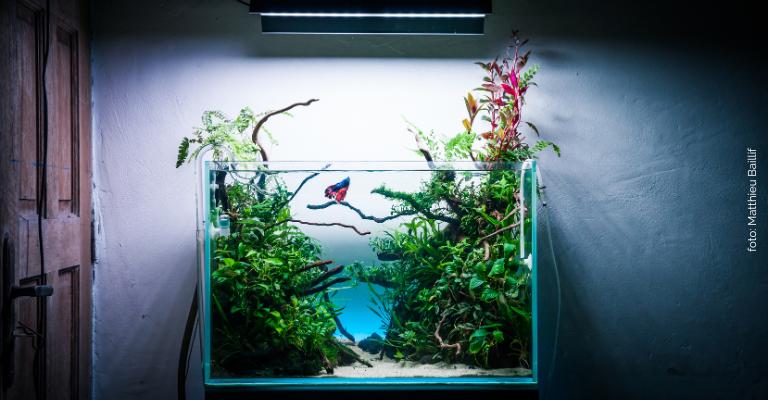
The right spectrum is essential for your planted aquarium because different wavelengths of light trigger specific biological responses. For plants, wavelengths in the blue (400-500 nm) and red (600-700 nm) ranges are most effective for photosynthesis. Meanwhile, the green light (500-600 nm) primarily enhances the visual appeal of the aquarium without overly benefiting plants but is still considered to be in the range of the full spectrum lighting that fish and plants are exposed to. A carefully selected light spectrum ensures that plants can grow efficiently, and fish remain healthy and stress-free.
I will explain further in this article which spectrum affects your plants and how to read a spectrum chart.
Kelvin vs spectrum
So the light spectrum is the range of wavelengths a light source produces. On the other hand, Kelvin (K) indicates the color temperature, ie, the warmth or “color tone” of the light source as perceived by humans. This is measured on a scale from 1000 to 12000 (or even higher) where the lower end is “warmer” and the higher end is “colder”.
- 1000K to 3000K: emits a warm, reddish light, creating a cosy atmosphere.
- 5500K to 6500K: mimics natural daylight.
- 6500K and above:emits as colder atmosphere
Many focus on Kelvin, thinking higher is better or that 6500K is the perfect choice for all planted tanks. However, a higher Kelvin (bluer or “cooler” light) doesn’t directly improve plant growth nor does the perfect Kelvin exist. In fact, it’s perfectly possible to have a 6500K lamp with a spectrum unsuitable for aquatic plants or 2 LED lights which are both 6500K but have a completely different spectrum.
So forget about Kelvin but try to focus on the spectrum when purchasing your new lamp.
Blue, red and green spectrum: what is their function?
Different light wavelengths, including parts of the UV spectrum, affect plant hormones in various ways. This is known as photomorphogenesis. It’s a process where light influences plant development, shape, biochemistry, and cell structure and function (R. E. Kendrick, 1994).
On terrestrial plants, for instance, the red spectrum triggers flowering (Demotes-Mainard et al., 2016) and the blue spectrum creates more compact plants (Cosgrove & Green, 1981). However, aquatic plants are different, and we cannot simply apply the same science to them.
Below, I have made a summary of the effects of the spectra on aquatic plants.
Blue light spectrum in aquariums
Blue light (400-500 nm) is crucial for promoting vegetative growth in aquatic plants, as it penetrates deeper into the water. This wavelength encourages the production of chlorophyll, which is essential for photosynthesis (Lucia et al., 2023).
Blue light can not only enhance photosynthesis in aquatic plants but could also be a natural way to reduce harmful algae and create a healthier aquarium ecosystem. It can increase the production of natural plant toxins produced by aquatic plants (Hao et al., 2025). These toxins are not harmful to the plant but act as defence mechanisms against algae and have therefore been found to reduce algae growth (Li, Zhao, Chen, & Wang, 2023).
However, higher stress responses in aquatic plants, which could lead to stress damage, can be caused by blue light compared to full-spectrum natural light (Wang et al., 2023). This means that, although blue light is important for photosynthesis in aquatic plants and may help control harmful algal blooms, balancing the light spectrum (by combining red, blue, and green light) is just as important to optimize plant health in aquariums.
I should note, however, that the species used in the study above is a submerged aquatic plant (Potamogeton crispus), but is not commonly used in aquariums. It is used often in ponds though.
Red light spectrum in aquariums
On the other hand, red light (600-700 nm) aids in root development and is particularly useful for encouraging flowering or more robust plant growth. Red light is highly efficient light to accumulate chlorophyll, even under low-nutrient conditions (Fan et al., 2024), boost photosynthesis (Lucia et al., 2023) and increase plant growth (Xu et al., 2019).
While red light is very effective, plant species can respond differently depending on the amount of red and blue light they receive. Adjustment of the red-to-blue light ratio can help stimulate the growth of different plant parts in aquatic plants. For example, a higher red-to-blue ratio (more red than blue light) makes some plants grow bushier and denser, while a lower red-to-blue ratio encourages plants to develop larger leaves and become more robust (Gao et al., 2023).
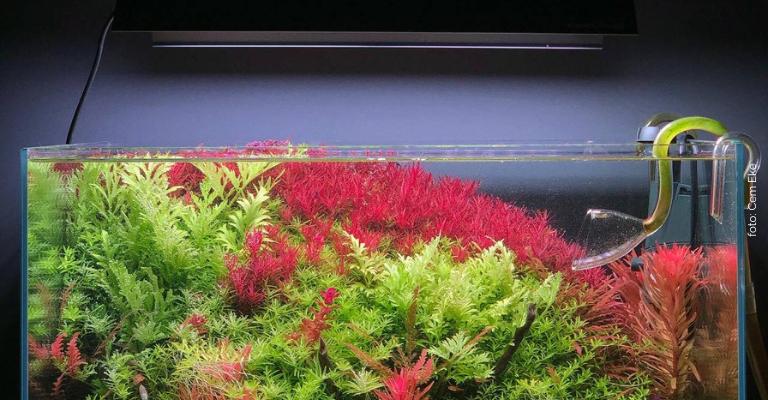
These two wavelengths combined provide the most beneficial spectrum for freshwater plant growth. The right combination of blue and red light creates an environment that fosters healthy plant growth while helping to prevent unwanted algae from taking over your tank. Striking this balance ensures that your aquarium’s flora remains lush and vibrant without compromising the overall health of the ecosystem.
Green light spectrum in aquariums
Green light is less efficient for photosynthesis (Liu & van Iersel, 2021), but it still plays an important role in plants by increasing overall light absorption, especially in shaded areas (Smith, Mcausland, & Murchie, 2017). While green light is less essential for plant growth, it also plays a role in enhancing the aesthetic of the aquarium.
Plants can alter their photosynthetic efficiency depending on the light composition they receive (Kordyum & Klimenko, 2013). Though green light is not heavily used by plants, it’s part of achieving a full-spectrum effect that mimics natural sunlight. Moreover, different light spectrums affect the reflectance and therefore appearance of foliage colour in aquatic plants (Everitt, Summy, & Yang, 2009). It helps create a more balanced look for human eyes, ensuring that plants and fish appear vibrant.
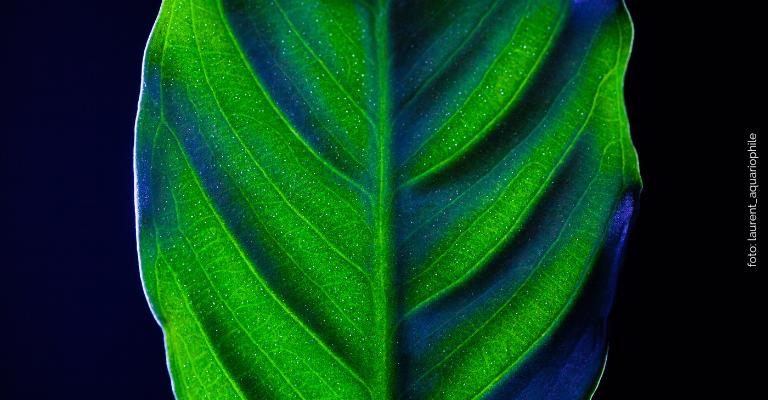
Overall, looking at the info above, we can claim that certain aquatic plant species exhibit stronger pigmentation when exposed to stronger red/blue light. The stronger red/blue light will also increase color saturation which is a nice bonus.
How to read a light spectrum chart
Below is a spectrum chart for the Twinstar G-Line. You can see a coloured curve with spikes at different intervals. The X-axis in this chart represents the wavelengths expressed in nm, the Y-axis represents the relative intensity of each wavelength. The spikes are caused by special phosphors introducted by the brand during the production of this particular light source. These can differ from brand to brand
Notice how this light source in particular has a balanced spectrum of green, blue and red which gives it a rather neutral appearance.

Here’s another example from a different brand, namely Skylight:
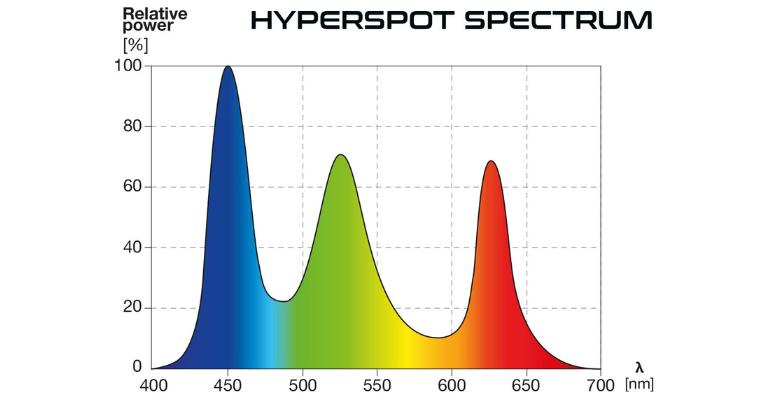
Choosing the best spectrum for your aquarium
Right, so now you know you have to look at the spectrum chart and not at the Kelvin rating (see chapter “Kelvin vs spectrum”) and you now understand the role each spectrum plays (see chapter “Blue, red and green spectrum: what is their function?”). But what would a good spectrum for your own tank look like?
First of all …
It’s often difficult to visualize the spectrum “in real life” so I recommend to always look up some examples of tanks which use the light you are looking at. This will give you an idea of how it will look for your aquarium.
Also, spectrum changes depending on the depth of your aquarium. This is because some wavelengths are better absorbed by the water column than others. For instance, the red spectrum is more easily absorbed than blue spectrum. According to research about 30% of the red spectrum is lost at 60cm of depth. Keep this in mind when you have an extra deep aquarium (Clarke & Oster, 1934; Kirk, 2010).
Keeping that in mind …
Choose a light source with a good green, orange and yellow base but with a nice spike in the red and blue parts of the spectrum chart. This will create a good condition for photosynthesis but with spikes in red and blue, this will have several added effects:
- Colours will pop more;
- Better leaf pigmentation, especially with red plants;
- More compact growth and fuller leaves (although phosphates can help here too!);
- Colours are saturated but not unbalanced (thanks to the green/yellow base).
Below is an example of a tank that uses a quality aquarium LED light with an excellent spectrum:
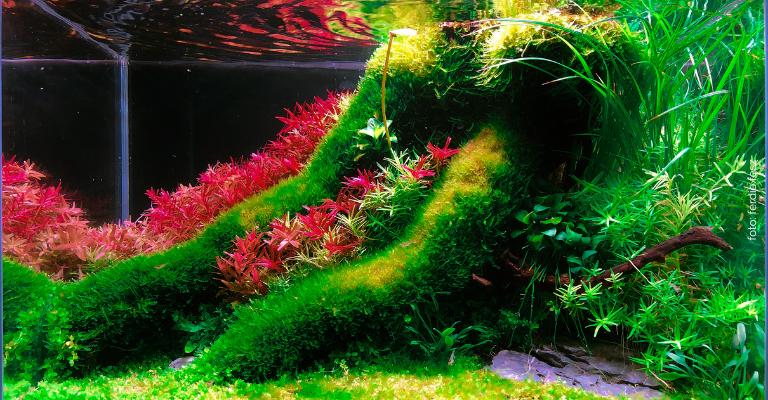
Unfortunately, these lights are more expensive than regular lights. But keep in mind that:
A) just like CO2, your light has a big impact on plant growth;
B) cheap brands are often not great for photosynthesis;
C) The tank will look rather “neutral” and boring if you go for the cheap stuff.
Below is an example of a not-so-ideal spectrum. Notice the spikes: there’s just one, often the blue or green. This will create a rather “bland” visual appearance of your plants and plant growth won’t be great either due to the lacking wavelengths.
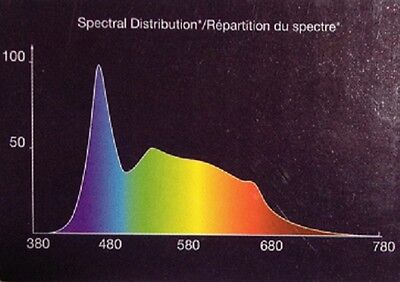
I recommend saving up some extra money to invest in a good quality light source. But make sure to also check the spectrum before purchasing, expensive does not always mean great spectrum (as proven in the image above). Choose a LED light source with RGBW diodes and ideally, look for lights with adjustable intensity and spectrum control (through an app). This allows you to customize the light output for specific plant needs or even mimic sunrise and sunset cycles if you need that. This level of control can dramatically impact the health and appearance of your aquatic plants and the well-being of your fish.
Choose a light source with a nice spike in red and blue, especially if you have a lot of red or purple plants. Choose one with a nice spike in green if you have a lot of green plants and want to make them pop.
Green spectrum: the myth of usage and algae
“Plants do not use the green spectrum”. You might have heard this one before, but it’s not really true …
Although plants indeed reflect some green light and it is less efficient for photosynthesis, plants still use it in important ways (Liu & van Iersel, 2021). Green light can reach deeper into the plant tissue and therefore helps to perform photosynthesis deeper within the leaves, which allows a better use of light in shaded areas (Smith et al., 2017). This can benefit aquarium plants as enough light for photosynthesis can be enabled even in shaded areas of the tank, promoting more healthy and compact growth.
There’s also the persistent myth that the green spectrum causes algae. However, there’s just no consistent proof or observation that this is true. Research has also found that the growth of microorganisms could even be slowed down by green light compared to other sources, however, depending on the type of microorganism (Vila & Abella, 1994). Although this study has focused on photosynthetic bacteria, the same principle could also apply to other photosynthetic organisms, such as algae.
I have added an example below of a tank that uses a good amount of green spectrum. If a green spectrum causes algae as some people claim, this tank should be infested with algae. Yet, this is not the case here:

Below is the spectrum of the ADA Solar RGB, the lighting used in the tank above. Notice the very high peak in green spectrum:
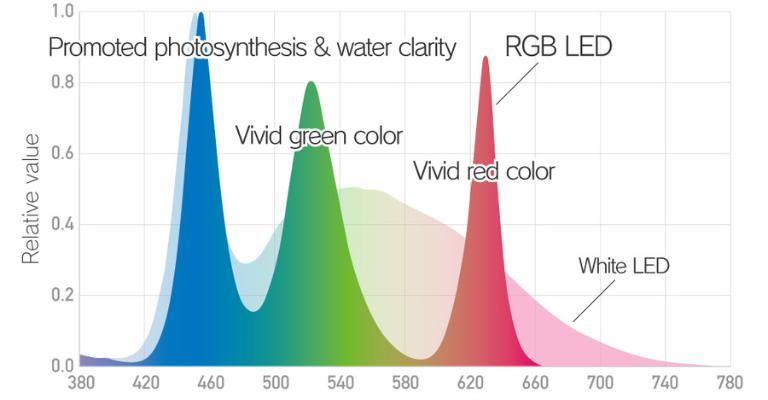
Conclusion
Selecting the best LED aquarium lights for your planted tank is an essential step toward crafting a stunning and healthy underwater world. By investing in high-quality LED aquarium lighting, you’re investing in the long-term vibrancy of your planted aquarium and the health of your plants. So take your time, and don’t be afraid to invest a little extra to get those incredible results you’re looking for.
Got any questions? Let me know in the comments below!
References
Clarke, G. L., & Oster, R. H. (1934). The Penetration of the Blue and Red Components of Daylight Into Atlantic Coastal Waters and Its Relation To Phytoplankton Metabolism. The Biological Bulletin, 67(1), 59–75. https://doi.org/10.2307/1537482
Cosgrove, D. J., & Green, P. B. (1981). Rapid Suppression of Growth by Blue Light. Plant Physiology, 68(6), 1447–1453. https://doi.org/10.1104/pp.68.6.1447
Demotes-Mainard, S., Péron, T., Corot, A., Bertheloot, J., Le Gourrierec, J., Pelleschi-Travier, S., … Sakr, S. (2016). Plant responses to red and far-red lights, applications in horticulture. Environmental and Experimental Botany, 121, 4–21. https://doi.org/10.1016/j.envexpbot.2015.05.010
Fan, L., Zhang, X., Li, Q., Liu, Y., Wang, H., & Zang, S. (2024). Removal of Nitrogen and Phosphorus in Low Polluted Wastewater by Aquatic Plants: Impact of Monochromatic Light Radiation. Water (Switzerland), 16(14). https://doi.org/10.3390/w16142002
Gao, X., Liu, H., Liu, G., Huang, W., & Xing, W. (2023). How functional traits of submerged macrophytes response to underwater light quality? Hydrobiologia, 5043–5058. https://doi.org/10.1007/s10750-023-05142-5
James H. Everitt, K. Rodney Summy, and C. Y. (2009). Spectral Reflectance and Digital Image Relations Among Five Aquatic Weeds Spectral Reflectance and Digital Image Relations Among Five Aquatic Weeds. Subtropical Plant Science, 61, 15–23.
Kirk, J. T. O. (2010). Absorption of light within the aquatic medium. Light and photosynthesis in aquatic ecosystems. https://doi.org/10.1017/cbo9780511623370.005
Kordyum, E., & Klimenko, E. (2013). Chloroplast ultrastructure and chlorophyll performance in the leaves of heterophyllous Nuphar lutea (L.) Smith. plants. Aquatic Botany, 110, 84–91. https://doi.org/10.1016/j.aquabot.2013.05.013
Li, X., Zhao, W., Chen, J., & Wang, F. (2023). Dosage impact of submerged plants extracts on Microcystis aeruginosa growth: From hormesis to inhibition. Ecotoxicology and Environmental Safety, 268, 115703. https://doi.org/10.1016/J.ECOENV.2023.115703
Liu, J., & van Iersel, M. W. (2021). Photosynthetic Physiology of Blue, Green, and Red Light: Light Intensity Effects and Underlying Mechanisms. Frontiers in Plant Science, 12, 619987. https://doi.org/10.3389/FPLS.2021.619987/BIBTEX
Lucia, M., Marian, M. L., Voșgan, Z., Mihalescu, B., Maxim, A., Roșca, O. M., … Năsui, D. (2023). Research on the Influence of Environmental Factors on the Intensity of Photosynthesis in the Aquatic Plant (Egeria densa), 55, 153–161.
R. E. Kendrick, G. H. M. K. (Ed.). (1994). Photomorphogenesis in plants – 2nd Edition. Kluwer Academic. Dordrecht: Kluwer Academic Publishers.
Smith, H. L., Mcausland, L., & Murchie, E. H. (2017). Don’t ignore the green light: exploring diverse roles in plant processes. Journal of Experimental Botany, 68(9), 2099–2110. https://doi.org/10.1093/JXB/ERX098
Vila, X., & Abella, C. A. (1994). Effects of light quality on the physiology and the ecology of planktonic green sulfur bacteria in lakes. Photosynthesis Research, 41(1), 53–65. https://doi.org/10.1007/BF02184145/METRICS
Wang, S., Wang, L., Zhang, M., Li, W., Xie, Z., & Huang, W. (2023). Blue Light Enhances Cadmium Tolerance of the Aquatic Macrophyte Potamogeton crispus. Plants 2023, Vol. 12, Page 2667, 12(14), 2667. https://doi.org/10.3390/PLANTS12142667
Xu, C., Wang, H. J., Yu, Q., Wang, H. Z., Liang, X. M., Liu, M., & Jeppesen, E. (2019). Effects of Artificial LED Light on the Growth of Three Submerged Macrophyte Species during the Low-Growth Winter Season: Implications for Macrophyte Restoration in Small Eutrophic Lakes. Water 2019, Vol. 11, Page 1512, 11(7), 1512. https://doi.org/10.3390/W11071512







